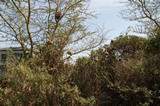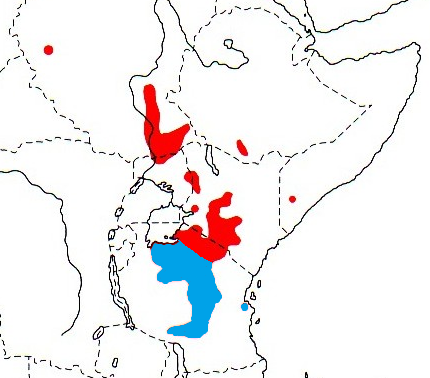Weaver species
Choose different species from drop-down list and press 'Go' button. See Full species list.Grey-headed Social Weaver Pseudonigrita arnaudi
IUCN: Least concern Discovery: 056Categories: cooperative, acacias, Gymnogene, Nest use, Pseudonigrita+Philetairus,
News items about species
Discovery
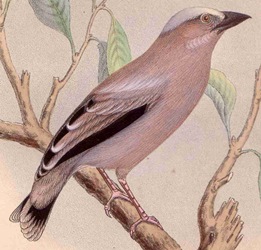
figure from Heuglin (1871) 
figure from Sharpe (1890) 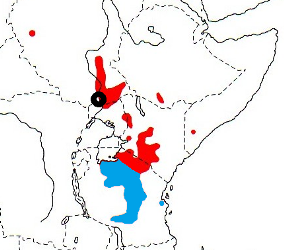
distribution, type locality circled IntroductionThe Grey-headed Social Weaver was formally described by Charles Lucien Bonaparte, a French biologist and ornithologist. Around 1849 Bonaparte began work on preparing a classification of all the birds in the world, visiting museums across Europe to study the collections. In 1850, he published the first volume of his Conspectus Generum Avium which included 3 weavers. Bonaparte studied the type specimen of the Grey-headed Social Weaver in the Paris Museum. He named it after the French collector Joseph-Pons d'Arnaud, a French engineer, hunter and explorer.Three expeditions were fitted out between 1839 and 1842 to search for the source of the White Nile. The second trip, with d'Arnaud as the scientific chief of the expedition, reached to around Juba. d'Arnaud collected a variety of birds, including the Grey-headed Social Weaver, which were sent to the Paris Museum. The first illustration of a Grey-headed Social Weaver is by Heuglin (1871). The next illustration was a line drawing of the bird's wing, published by Sharpe (1890). Reichenbach (1863) mentioned the species, and provided an English name, but did not illustrate it. Scientific citationNigrita arnaudi Bonaparte 1850 Consp. Gen. Av., 1, p.444 White Nile, Sudan.Meaning of namesarnaudi - named after A. d'Arnaud, French explorer in the Sudan and Ethiopia.First English nameArnauds Nigrita (Reichenbach 1863).Alternate namesMasai Grey-headed Social Weaver.CollectorJoseph-Pons d'Arnaud.Date collected1839-1842.Locality collectedNil. albo = White Nile.Type specimensThe type specimen is probably in the Paris Museum. |
The above is based on Weaver Wednesday 2, a weekly series about the discovery of each weaver species.
This species text first appeared as
Weaver Wednesday [173] - Discovery [56]: Grey-headed Social Weaver on 2015-10-07
1. Basic biology
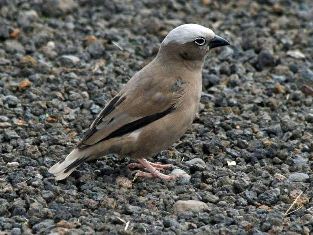
figure from wikipedia The Grey-headed Social Weaver is similar to the only other species in its genus, the Black-capped Social Weaver. The two species can occur together, although the Grey-headed usually prefers wetter areas than the Black-capped.
Distribution.
The Grey-headed Social Weaver is found in eastern Africa. Two subspecies are currently recognised (see map right, based on Birds of Africa):
Habitat.
The Grey-headed Social Weaver is found in bush and acacia woodland.
Food. The Grey-headed Social Weaver feeds mostly on the ground, eating grass seeds and insects, the latter including grasshoppers, beetles, termites and caterpillars. They feed their young on soft green grass seeds and insects. They drink regularly. Breeding.
The Grey-headed Social Weaver is a colonial, monogamous, co-operative breeder. Several groups of 2-10 birds occupy a colony, each group having 2-8 nests, with up to 157 nests, sometimes touching, in a single tree. Sub-adult helpers may assist in feeding young. Breeding depends on rainfall and at some colonies, eggs are laid in all months of the year.
The nest (photo right is built by both sexes and is a large, compact grass structure firmly attached to thin branches. The nest is symmetrical, with 2 openings below in roosting nests, but one entrance is closed when eggs are laid. The nest is made of straight grass stems, and placed like thatch around a central cavity. Birds constantly add to and modify the nest. Incubation is by both sexes. Pairs with helpers raise more young than pairs without helpers. Old nests are used by Cut-throat Finches Amadina fasciata, while Chestnut Sparrows Passer eminibey actively take over new nests. |
The above is based on Weaver Wednesday, a weekly series about weaver species.
This species text first appeared as
Weaver Wednesday [25]: Grey-headed Social Weaver on 2012-12-05
2. Breeding facts
| Pair bond Monogamous; sometimes co-operative breeder, e.g. 25-30% of nests at a Kenyan colony had helpers. Colonial Breeding season in all months; peak Aug-Dec in Sudan and Mar-May in Ethiopia and E Africa Nest site attached to thin branches, often of ant-gall acacia (Acacia drepanolobium), sometimes in other acacias (A. mellifera, A. senegala, A. tortilis) Nest building Nest built by both sexes Colony size up to 157 nests, some in fused mases, in single tree Clutch size 3-4 Egg colour greenish or blue-white, often plain white with fine olive or black specks concentrated at thick end, sometimes heavily blotched olive-brown and ash-grey Egg size average size of six eggs 19 x 14 mm (Kenya) Incubation incubation by both parents (in captivity, 70% of work by female), period 13-14 days Chicks and nestling period young fed by both parents and by helpers,latter predominantly males (which contribute most when food demand by chicks greatest), nestling period 20 days |
Breeding information based on Handbook of the Birds of the World, Vol. 15.
3. Photos of Weaver Nests
 Vm 28567 |  Vm 28042 |  Vm 27988 |  Vm 27418 |  Vm 23385 |  Vm 23384 |
Thumb-nails of most recent PHOWN records - click on one to see its full record
See all PHOWN records for this species here.
PHOWN (Photos of Weaver Nests) provides valuable info on breeding distribution and colony sizes of weavers.
You can contribute by registering and submitting photos at Virtual Museum webpage.
4. Breeding distribution
Google map showing distribution (For species with small ranges you need to zoom in at the correct area to see the range):
yellow blob - range of weaver species; read more about this here.
![]() - PHOWN records with photos
- PHOWN records with photos
![]() - PHOWN records with no photos (Nest Record Cards, other records)
- PHOWN records with no photos (Nest Record Cards, other records)
![]() - Birdpix records
- Birdpix records
![]() - comments on out of range records, or interesting records
- comments on out of range records, or interesting records
![]() - type locality
- type locality
CLICK on the marker on the map to see individual record details.
5. Range changes
Not South African speciesThe above is based on Weaver Wednesday 3, a weekly series about range changes in South African weaver species.
This species text first appeared as
n/a








